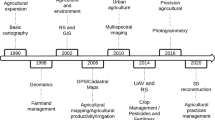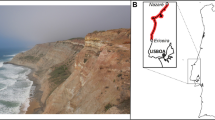Abstract
The availability of historical land cover data is a major challenge to long term land change analysis. This is more so in developing countries like Nigeria with weak land information systems and poor inventories of long term land cover data. This situation is to some extent ameliorated by the existence of topographic maps which represent encryptions of historical snapshots of land condition based on primary sources like aerial and land surveys. Topographic maps are however not easily amenable to analysis for land cover data extraction, given their inherent characteristics. This paper presents a GIS-based digitization, symbols analysis, pattern recognition, and polygonization methodology for the extraction of land cover information from topographic maps. The methodology is demonstrated with sheets in the Nigerian topographic map series covering the Idemili River basin. Results show that indigenous settlement types, derived Savanna, and residual forests occupied 27%, 35% and 24% of the basin area, respectively, during the period. An internal data validation approach showed a significant correlation (p = 0.000; r = 0.975) between base topographical map and extracted cover data. There is a need to apply the methodology to other topographical sheets in country’s inventory to build up a national digital database of historical land cover.
Zusammenfassung
Die Verfügbarkeit historischer Landbedeckungsdaten ist eine große Herausforderung für die langfristige Analyse von Landveränderungen. Dies gilt insbesondere für Entwicklungsländer wie Nigeria mit schwachen Landinformationssystemen und schlechten Beständen an langfristigen Landbedeckungsdaten. Diese Situation wird in gewissem Maße durch die Existenz topographischer Karten verbessert, die historische Momentaufnahmen des Landzustands repräsentieren, die auf Primärquellen wie Luft- und Landvermessungen basieren. Topographische Karten sind jedoch aufgrund ihrer inhärenten Eigenschaften für eine Analyse zur Extraktion von Landbedeckungsdaten nicht leicht zugänglich. In diesem Artikel wird eine GIS-basierte Digitalisierungs-, Signaturenanalyse-, Mustererkennungs- und Polygonisierungsmethode zur Extraktion von Landbedeckungsinformationen aus topografischen Karten vorgestellt. Die Methodik wird anhand von Blättern der nigerianischen topographischen Kartenserie demonstriert, die das Einzugsgebiet des Flusses Idemili abdecken. Die Ergebnisse zeigen, dass einheimische Siedlungsstrukturen, abgeleitete Savannen und Restwälder im Berichtszeitraum 27%, 35% bzw. 24% der Beckenfläche einnahmen. Ein interner Datenvalidierungsansatz verweist auf eine signifikante Korrelation (p = 0,000; r = 0,975) zwischen der topographischen Basiskarte und den extrahierten Landbedeckungsdaten. Es ist notwendig, die Methodik auf andere topografische Blätter im Inventar des Landes anzuwenden, um eine nationale digitale Datenbank aufzubauen






(Source: LULC data extraction from topographic maps of Idemili River Basin)

Source: LULC data extraction from topographic maps of Idemili River basin

Similar content being viewed by others
References
Adeniyi PO (1983) Aerial photographic method of estimating urban population. Photogram Eng Rem Sens 49(4):545–560
Adeniyi PO (2009) Geo-information technology and development: a compedium of selected papers. Wura Kay Prints, Ibadan, pp 162–173
Akinyemi FO (2003) The Nigerian topographic map digitalisation initiative: current work. In: Geo-information for practice, the international archives of photogrammetry, remote sensing and spatial information sciences (IAPRsSIS), Vol. XXXIV, Part 6, The International Society for Photogrammetry and Remote Sensing (ISPRS) WGVI/3 Workshop, Zagreb, Croatia, pp 7–11
Arsanjani, J J (2012): Dynamic land-use/cover change simulation: geosimulation and multi agent-based modelling. In: Springer Theses. https://doi.org/10.1007/978-3-642-23705-8_2
Atilola O (1993) Mapping with SPOT satellite imagery: the Nigerian experience. Int Arch Photogram Rem Sens 29:116–126
Bloch R, Fox S, Monroy J, Ojo A (2015) Urbanisation and Urban Expansion in Nigeria. Urbanisation Research Nigeria (URN) Research Report. London: ICF International
Chang-Martínez LA, Mas J, Valle NT, Torres PSU, Folan WJ (2015) Modeling historical land cover and land use: a review from contemporary modelling. ISPRS Int J Geo-Inf 4:1791–1812. https://doi.org/10.3390/ijgi4041791
Chiang Y-Y and Knoblock CA (2011) Recognition of multi- oriented, multi-sized and curved text. In: Proceedings of 11th conference on document analysis and recognition, pp 1399–1403
Chiang Y-Y, Leyk S, Knoblock CA (2014) A survey of digital map processing techniques. ACM Comput. Surv 47:44. https://doi.org/10.1145/2557423
Delmelle EM (2012) Spatial Sampling, Handbook of Regional Science. https://pages.uncc.edu/eric-delmelle/wp-content/uploads/sites/150/2012/12/Spatial-Sampling-Regional-Science-Chapter.pdf. Accessed 21 Aug 2018
Edler D, Keil J, Wiedenlübbert T, Sossna M, Kühne O, Dickmann F (2019) Immersive VR experience of redeveloped post-industrial sites: the EXAmple of “Zeche Holland” in Bochum-Wattenscheid, KN. J Cartogr Geogr Inf 69:267–284. https://doi.org/10.1007/s42489-019-00030-2
Ejikeme JO, Igbokwe JI, Igbokwe EC, Ezeomedo IC (2014) The revision of 1:50000 Topographic map of onitsha metropolis, Anambra state, Nigeria using Nigeriasat-1 imagery. Int J Eng Manag Sci 5(4):235–240
Fang-Chih L, Tzu-Ying L, Yen-Hung L (2009) Maps and GIS digitization procedures guideline, international collaboration and promotion of Taiwan e-Learning and Digital Archives Program. http://collab.teldap.tw. Accessed 27 Oct 2020
Farina A (2000) The cultural landscape as a model for the integration of ecology and economics. Bioscience 50(4):313–320. https://doi.org/10.1641/0006-3568(2000)050[0313:TCLAAM]2.3.CO;2
Floyd B (1969) Vegetation in Eastern Nigeria. Palgrave Macmillan, London, pp 152–165. https://doi.org/10.1007/978-1-349-00666-3_9
FME (2015) National biodiversity strategy and action plan 2016–2020, Abuja: Federal Ministry of Environment, p 17
FSN- Federal Surveys of Nigeria (1964) Onitsha, SE Sheet 300 SE, First Edition, Nigeria 1:50,000 Topographic Map Series
Foresman TW, Pickett STA, Zipperer WC (1997) Methods for spatial and temporal land use and land cover assessment for urban ecosystems and application in the greater Baltimore-Chesapeake region. Urban Ecosyst 1:201–216
García-Alvarez D (2017) Cartographic scale and minimum mapping unit influence on LULC modelling. In: Proceedings of the 3rd international conference on geographical information systems theory, applications and management (GISTAM 2017), pp 327–334
Goldewijk KK, Ramankutty N (2004) Land cover change over the last three centuries due to human activities: the availability of new global data sets. GeoJournal 61:335–344
Govedarica M, Borisov M (2011) The analysis of data quality on topographic maps. Geodetski Vestnik 55(4):713–725
Harrison SP, Stocker BD, Goldewijk KK, Kaplan JO, Braconnot P (2018) Do we need to include anthropogenic land-use and land-cover changes in paleoclimate simulations? Magazine 26(1):4–5. https://doi.org/10.22498/pages.26.1.4
Ifatimehin OO, Ujoh F, Eneche PSU (2014) Attributes of topographic mapping of a fast urbanising area in Nigeria, using remote sensing and GIS. J Sci Res Rep 3(1):170–184
Kaim D, Kozak J, Ostafin K, Dobosz M, Ostapowicz K, Kolecka N, Gimmi U (2014) Uncertainty in historical land-use reconstructions with topographic maps. Quaest Geogr 33(3):55–63. https://doi.org/10.2478/quageo-2014-0029
Kaim D, Kozak J, Kolecka N, Ziołkowska E, Ostafin K, Ostapowicz K, Gimmi U, Munteanu C, Radeloff VC (2016) Broad scale forest cover reconstruction from historical topographic maps. Appl Geogr 67(2016):39–48
Kim NW, Jeongjin LB, Hyungmin L, Jinwook S (2014) Accurate segmentation of land regions in historical cadastral maps. J Vis Commun Image Represent 25(5):1262–1274
Kraak M-J (2002) Geovisualization illustrated. ISPRS J Photogram Rem Sens 57(2003):390–399
Lawrence RL, Means JE, Ripple WJ (1996) An automated method for digitizing color thematic maps. Photogram Eng Rem Sens 62(11):1245–1248
MacEachren A, Ganter JH (1990) A pattern identification approach to cartographic visualization. Cartogr Int J Geogr Inf Geovisualiz 27(2):64–81. https://doi.org/10.3138/M226-1337-2387-3007
Walsh SJ, Lightfoot DR, Butler DR (1987) Recognition and assessment of error in geographic information systems. Photogram Eng Rem Sens 53(10):1423–1430
Maduekwe NI (2014) Assessment of spatio—temporal changes and environmental sustainability in the idemili river basin Of Anambra State, Nigeria, Unpublished PhD Thesis Submitted to Department of Geography, Obafemi Awolowo University, p 306
Maduekwe NI, Adesina F (2015) Remittances economy, remittances landscape: an analysis of the economic and socioecological implications of remittances to households in South Eastern Nigeria. GeoJournal 80(5):19. https://doi.org/10.1007/s10708-015-9674-y
NOAA (2020) What is the difference between land cover and land use? www.oceanservice.noaa.gov/facts/lulc. Accessed 25 Oct 2020
Ofomata GEK (1998) Land degradation in SE Nigeria. J Appl Soc Sci 1:5–14
Okoye NM, Orakwe LC (2018) Influence of surrounding land use on the physicochemical parameters of Agulu Lake, Anambra State, Nigeria. Arch Curr Res Int 12(2):1–9. https://doi.org/10.9734/ACRI/2018/39397
Ostafin K, Iwanowski M, Kozak J, Cacko A, Gimmi U, Kaim D, Psomas A, Ginzler C, Ostapowicz K (2017) Forest cover mask from historical topographic maps based on image processing. Geosci Data J 4:29–39. https://doi.org/10.1002/gdj3.46
Phil-Eze P (2010) Variability of soil properties related to vegetation cover in tropical rainforest landscape. J Geogr Reg Plan 3(7):177–184
Sepp E (2004) Historical land use reconstruction in the research area around Lake RõugeTõugjärv. In: Unpublished BSc Theses, University of Tartu
Smith MJ, Hillier JK, Otto J-C, Geilhausen M (2013) Geovisualization. In: Shroder JF (ed) Treatise on geomorphology, vol 3. Academic Press, San Diego, pp 299–325
Ufuah ME (2006) Non-revision of 1:50,000 topographic maps and its implications for sustainable development in nigeria a paper presented at the proceedings of the 21st International cartographic conference, Durban, South Africa, pp 12
USGS (2013) Landsat—a global land-imaging mission USGS Fact Sheet 2012–3072. http://www.usgs.gov/. Accessed 7 Sep 2018
Widgren M (2018) Towards a global history of agricultural systems. Magazine 26:1. https://doi.org/10.22498/pages.26.1.18
Yartseva V, Besimbaeva O, Khmyrova O (2018) Analysis of errors in the creation and updating of digital topographic maps. Geodesy Cartogr Polish Acad Sci 67(1):143–151. https://doi.org/10.24425/118703
Author information
Authors and Affiliations
Corresponding author
Rights and permissions
About this article
Cite this article
Maduekwe, N.I. A GIS-Based Methodology for Extracting Historical Land Cover Data from Topographical Maps: Illustration with the Nigerian Topographical Map Series. KN J. Cartogr. Geogr. Inf. 71, 105–120 (2021). https://doi.org/10.1007/s42489-020-00070-z
Received:
Accepted:
Published:
Issue Date:
DOI: https://doi.org/10.1007/s42489-020-00070-z




